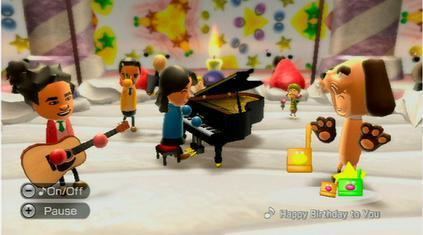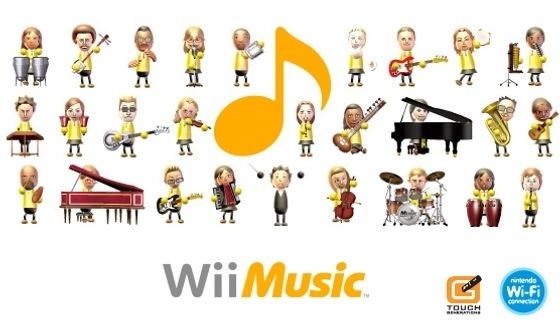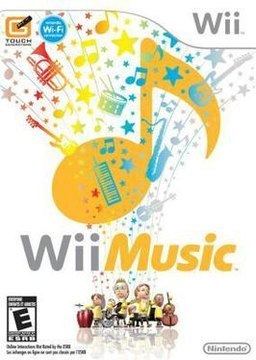5.6 /10 1 Votes5.6
63% Metacritic Initial release date 16 October 2008 | 5/10 IGN Platform(s) Wii Genre Music video game | |||||||||||||||||||||||||||||||||
 | ||||||||||||||||||||||||||||||||||
Composer(s) Toru MinegishiKenta NagataMahito Yokota Similar Wii Series games, Shigeru Miyamoto games, Music video games | ||||||||||||||||||||||||||||||||||
Wii music part 1 the best game of all time ever
Wii Music (Japanese: Wiiミュージック, Hepburn: Wī Myūjikku) is a free-form music game developed and published by Nintendo for the Wii video game console. The game was released in Japan and North America in October 2008, and in Europe and Australia in the following month. Wii Music is part of both Nintendo's Touch! Generations brand and the Wii series.
Contents
- Wii music part 1 the best game of all time ever
- Gameplay
- Instruments
- Jam Mode
- Songs
- Minigames
- Development
- Critical
- Sales
- Sequel
- References

Wii Music focuses on creating arrangements of existing songs by controlling the members of an on-screen band. In order to do so, players choose from a wide selection of musical instruments that are played by mimicking the required actions using the Wii Remote and Nunchuk. Unlike other music games, such as Guitar Hero and Rock Band, players are not scored on their performance and are encouraged to experiment with different ways to play various songs. The game has been advertised by Nintendo as a means of "bring[ing] the joy and creativity of musicianship to [one's] home without expensive music lessons."

Wii Music was one of the original titles announced for the Wii console, first publicly playable at E3 2006, and then later re-introduced in greater detail at E3 2008. Upon release, Wii Music received mixed reviews, gaining aggregate scores of 64.34% on GameRankings and 63 on Metacritic, with common criticism directed at its simple gameplay and its predominantly public-domain soundtrack. As such, it is regarded as the black sheep of the Wii series and is also one of the least commercially successful entries, selling 2.65 million copies worldwide as of March 2009.

Gameplay
Wii Music gameplay focuses on playing and arranging songs through improvisation using various instruments. Similar to how Wii Sports simulates playing sports by mimicking the required gestures using the motion sensitive Wii Remote, Wii Music simulates playing music by mimicking the actions associated with the different instruments. Like all games in the Wii series, the players control Mii characters created using the console's Mii Channel.
Instruments
The game offers a selection of sixty-six playable instruments, including the violin, drum, cowbell, flute, clarinet, saxophone, harmonica, piano, guitar, trumpet, harp, shamisen, maracas, sitar and marimba, as well as unconventional instruments such as dog and cat sounds, pseudo doo-wop vocals (singer), karate shouts (blackbelt), cheerleader cheers, and 8-bit sounds.
To play each of the instruments, the player mimics the required motions with the Wii Remote and the Nunchuk. Because of the varying techniques required to play different instruments, the instruments in Wii Music are divided into "groups" to which certain movements or button presses play single notes. For example, instruments such as keyboards and percussion require the player to swing the controllers as if striking drums; and some string instruments such as the violin and the guitar are played by moving the Wii Remote as if drawing a bow or strumming the strings, while the Nunchuk is held as if the gripping the instrument's neck and fingerboard. The Wii Balance Board can also be utilized in playing the various drum kits, emulating the foot-operated pedals. All instruments have extra playing options, where additional button-presses or restricted movements have different effects on the sound. Softer notes can be played with slower Wii Remote movement, and holding various buttons can create damping, muting, chords, tremolo, arpeggio, and glissando.
Jam Mode
The game's main feature, Jam Mode, features 50 songs that consist of a combination of classical and traditional songs, seven Nintendo songs, and 15 licensed songs. Before playing the selected song, the players each choose any of the available instruments and then perform as one of six different members of a band; the six available sections are melody, harmony, chord, bass, and two percussion parts. Unoccupied sections are played by computer-controlled "Tute" characters or can be dropped altogether.
Unlike other music games such as Rock Band or Guitar Hero where players are scored based on playing certain notes at specific times, Jam Mode lacks a scoring system and does not objectively penalize for missing or playing "incorrect" notes nor do players have any control over the pitch of the notes played. Instead, the internal music track for each section of all songs is specially programmed to respond to all possible player actions: the game will attempt to make any notes played be harmonious to the song, including those played outside the original melody. Consequentially, players are encouraged to practice and experiment with different ways to play songs using any arrangement of instruments, either choosing to stick close to the guide or diverge from it and create unique compositions. The quality of the new arrangement is up to the player's judgement. Players can also do what is called an "Overdub" session in which the same song is played again controlling a different musician or instrument; this allows the players to play over the music recorded in previous playthroughs and allows a single player to play all parts of a band. Players can then save their overall performance as a music video for later playback, or share it with other players via WiiConnect24.
Wii Music also supplies templates of each song according to existing music genres, such as pop, march, rock, and jazz, and players can take interactive tutorials to learn how to fit a song to a particular style.
Songs
There are 50 songs included in Wii Music, with 8 being classical, 22 being traditional, 13 popular and 7 from Nintendo game soundtracks. Only five songs are available from the start of the game with the rest having to be unlocked.
Minigames
Along with the freeform Jam Mode, Wii Music features three minigames that feature a scoring system:
Development
Wii Music was first shown, along with the Wii Remote, at the Nintendo press conference at the 2005 Tokyo Game Show. The two minigames briefly featured were Drums and Orchestra. The game was also the first Wii game ever to be demonstrated during Nintendo's E3 2006 press conference, where Shigeru Miyamoto came up to the stage to perform the The Legend of Zelda Overworld Theme for the audience using the Orchestra game. Both Drums and Orchestra were also made playable to attendees. Additional details of the game were released in conjunction with a Nintendo press conference held on October 11, 2007.
Wii Music was showcased during Nintendo's press conference for E3 2008, revealing much more information, including support for the Wii Balance Board to play the drums. It was revealed later on that the game has lessons for the drums programmed in. Miyamoto later announced that over 61 instruments will be playable in the game, and explained the control scheme that uses the Wii Remote's buttons to play notes on various instrument while holding the Wii Remote in a similar fashion to the actual instrument.
Critical
Critical reception to the game was mixed, with a 63% aggregate score at Metacritic. Wii Music was given a score of A- by 1UP.com by Jennifer Tsao, who believed the game has a "surprising depth and flexibility" that rewards players who have mastered the controls. She also felt that the game's four-player custom jam mode was addictive, but lamented the abundance of public domain songs in the soundtrack. This review greatly contrasted the reviews of other editors on 1UP, who complained about a lack of depth and content. It was given 80% by Official Nintendo Magazine who praised the surprising depth of the game. GameSpy, who gave it 3.5/5, called the game an "odd duck" and something "more akin to a tech demo or social audio experiment" with little to interest adults, but is simple enough to be accessible to everyone and believed it would be a hit with young children and their families. Wii Music also got a 6.5/10 from GameSpot, who said that Wii Music, while fun and easy to pick up and play, is hard to recommend because older children and adults would only get a few hours of entertainment.
The game received a 5/10 from IGN, who called the game "a noise maker tied to a series of gestures" and cited "gimmicky" controls and poor sound quality, in addition to a "fundamentally flawed" soundtrack. However, they also felt that children may enjoy the game much more than adults, who they believe may "grow bored of the experience in a matter of hours, if not minutes". Game Informer gave the game a 3/10, calling it "a poor solution to an imaginary problem". GameTrailers gave it 5.8/10, criticizing the "ancient" song list and emphasis on video creation.
Sales
The game sold 92,000 copies in its first week of release in Japan. It was the 30th best-selling game of Japan in 2008. In North America, the game sold around 66,000 copies in around the same period after release. Shigeru Miyamoto has stated that the game's sales had not been as strong as originally hoped, with a possible reason for this being competition from established music and rhythm games series such as Guitar Hero and Rock Band which are dominating the market. Cammie Dunaway, Nintendo of America's executive vice president of sales and marketing, suggests Wii Music will be an "evergreen" title that will see continued sales in the long run. Wii Music was the tenth best selling game in the US for the month of November 2008 and the 11th best-selling game in the following month in the United States with more than 480,000 copies sold, and has sold 865,000 units in North America in 2008 according to the NPD Group. As of March 2009, Wii Music has sold 2.65 million copies worldwide.
Sequel
In an interview, Shigeru Miyamoto said "Wii Music was a really unique game, and even today, we are receiving several different offers from people in the field of music education. I think it still has great potential." Asked about future plans, Miyamoto could only drop hints. "Unfortunately, we don't have any news we can talk about at the moment. But like Wii Fit Plus, it's not really a sequel to the original Wii Fit – but we have added some features to improve the overall experience. It's kind of an enhanced version."
